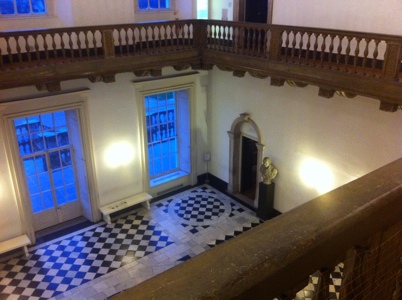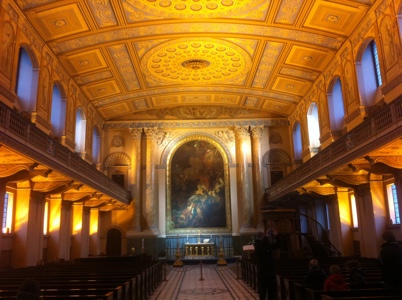While tourists dominate at the weekend in Greenwich, during the week there is an influx of students. That’s because since 1998, the University of Greenwich and Trinity Laban Conservatoire of Music and Dance have occupied the buildings that for more than a century were home to the Royal Naval College.
And for music students in particular, the setting could not be better. Christopher Wren’s chapel, which dates back some 300 years and sits at the heart of an amazing complex of grand English baroque style buildings, is a wonderful performance space.
Yet while the campus may have been used from 1873 to 1998 by the Royal Navy College, the buildings were created for a different purpose – that of a hospital (latterly known as Greenwich Hospital) for veteran sailors. When it opened in 1705 there were 42 residents, but numbers would go on to a peak of 3,000.
As you will have read in my blog yesterday, Greenwich was famed for its spectacular Tudor palace, enjoyed by Henry VIII and Elizabeth I. But bar a distinctive white house called the Queen’s House that was commissioned by James I and now part of the National Maritime Museum, the Royal estate was then largely neglected.
Following the Civil War and subsequent Commonwealth period, the palace was in ruins (the Queen’s House had fared a little better, having been used during Cromwell’s rule as a barracks and then a biscuit factory). Charles II, however, returned from exile in France after the Restoration of the monarchy and had ambitious plans to re-build Greenwich Palace so that it was as grand as that he’d seen at Versailles.
Unfortunately for the King, his vision wasn’t quite on par with the funds he had to complete his project (the Great Plague in 1665 didn’t help either) and over time he lost in the project. With the Tudor palace largely still in ruins, Greenwich’s history could have turned out differently had it not been for Queen Mary commissioning Christopher Wren, supported by Nicholas Hawksmoor and Sir John Vanbrugh, to build a hospital for veteran sailors.
The architects took the part-completed King’s House, the only structure realised from Charles II’s plan to build a new palace at Greenwich as a starting point. It was built in two halves, with an attractive courtyard in the middle, so the Queen’s House would maintain its river view. Building work took 55 years to complete – the delay caused by problems raising the necessary finances. Each side has a small dome, miniature versions of those put on St Paul’s Cathedral.
It’s these distinctive white buildings that line Greenwich’s waterfront to this day.
The Royal Charter of William and Mary dated 25th October 1694 established the Royal Hospital for Seamen (latterly known as Greenwich Hospital) as a home for retired seamen of the Royal Navy, and to provide support for seamen’s widows and education for their children, and the improvement of navigation, as detailed in its original charter:
“The reliefe and support of seamen serving on board the shipps or vessells belonging to the Navy Royall who by reason of Age, Wounds or other disabilities shall be uncapable of further service at sea and being unable to maintain themselves.
“And for the Sustentation of the Widows and the Maintenance and Education of the Children of seamen happening to be slain or disabled. Also for the further reliefe and Encouragement of seamen and Improvement of Navigation.”
Visiting the complex today, Dr Samuel Johnson’s comments that Greenwich Hospital was “far too magnificent for a place of charity” make perfect sense.
Wren’s chapel, rebuilt by James ‘Athenian’ Stuart in 1779 following a fire, was where the veterans would have been required to attend services every day. Unlike today, there wouldn’t originally have been pews so they were forced to standing for long periods. They must have been in awe of the plasterwork decorations (the present Greek Revival interior dates from following the fire) that visitors see today.
On the other side of the courtyard, James Thornhill spent 19 years painting the allegorical scenes on the walls and ceilings of what is now called the Painted Hall and contains the largest figurative painted interior in the country. The lower hall ceiling pays tribute to King William and Queen Mary, seated in glory in the middle of the central oval, and the importance of naval power to the fortunes of the nation.
When it was completed, it was deemed to lavish for veterans so was reserved for special occasions and visitors (the residents therefore ate their meals of bread, beer and boiled meat in the undercrofts below). It was used as a smart dining hall when it was occupied by the Naval College and is still a venue for grand functions to this day.
It was in the Painted Hall where Lord Nelson’s body lay in state for three days so that people could pay their final respects for our Navy hero. Tens of thousands descended on Greenwich before a flotilla of barges accompanied his body to St Paul’s cathedral for the funeral.
To get a sense of what daily life was like for the veterans, it’s worth looking in the nearby Discover Greenwich exhibition centre. Here they’ve mocked up a bedroom and visitors can try on a blue overall, similar to what the residents would have worn.
In addition to visiting the chapel and the Painted Hall, it’s worth having a look at the Skittle Alley if you can. Its here where, as the Chalk Walk, the residents were allowed to smoke their clay pipes or ‘chalks’.
But by the 1850s Britain was fighting far less sea battles and so the hospital was no longer needed. Moreover, the grand buildings masked the Spartan living conditions that the pensioners faced inside.
The hospital was closed in 1869 and four years later the Royal Naval College opened in response to the need to train sailors in a formal classroom setting rather than just on-board ships.
And the Royal Charter of William and Mary dating to 1694, that established the Royal Hospital for Seamen is still having an impact today. The charity provides sheltered housing for eligible elderly seafarers and substantial grants to naval charities.
Categories: Changing London, South East London



Fabulous. You have a wonderful way of bringing places to life and into the modern day. Added to my ever growing list of ‘Blog places I want to visit’
Thanks again for the nice words
Wonderful surroundings – what lucky students.